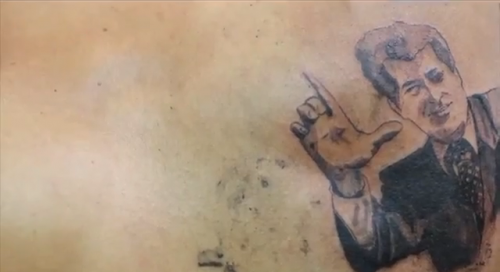“El Sexto” the Graffiti Artist: From the Wall to His Skin
by Orlando Luis Pardo Lazo / October 1, 2012 / No comments
Can you censor a body of art as it walks down the street?

El Sexto is tattooed with a portrait of Oswaldo Payá. Photo: YouTube, Orlando Luis Pardo Lazo
He’s 29 years old and he lives in Havana. His name is Danilo Maldonado and he’s a graffiti artist, half genius and half ingenuous. He is one of the very few free artists in post-revolutionary Cuba.

- Is it worth-while to focus on the last images and letters coming from the inside of the last living utopia on Earth? Is Cuba by now a contemporary country or just another old-fashioned delusion in the middle of Nowhere-America? A Cold-War Northtalgia maybe? Can we expect a young Rewwwolution.cu within that Ancien Régime still known as The Revolution? I would like to provoke more questions than answers.

- Orlando Luis Pardo Lazo was born in Havana City and still resides and resists there, working as a free-lance writer, photographer and blogger. He is the author of Boring Home (2009) and is the editor of the independent opinion and literary e-zine Voces.
The façades of our capital city had been taken over by his tag “El Sexto” (“The Sixth”) until the government decided to cover them up. This cult copyright implied that, fed up with the official campaign for the “Five Heroes” (who were convicted of espionage in the USA), he was proclaiming himself a new hero of protest.
Maldonado has created many pieces of political graffiti, and this genre has put him in prison more than once—fortunately without legal consequences, thanks to the solidarity that his art has awoken both within and outside of our borders. He has even put on two exhibitions of his work, but always at the homes of colleagues, since the institutional galleries remain closed to him.
One night, when Maldonado was pursued by secret agents, they destroyed a T-shirt on which a piece of his art payed homage to Laura Pollán, the leader of the pro-human rights movement Damas de Blanco (Ladies in White) who died in suspicious circumstances in a hospital in 2011. In protest, El Sexto tattooed the artwork onto his chest. Since then he has transformed his body into a temple, a living cry for freedom, something unprecedented in the history of Cuban resistance.
This month he’s added a tattoo of the founder of the Christian Liberation Movement, Oswaldo Payá, who died in a suspicious traffic accident together with fellow dissident Harold Cepero. Maldonado’s plan is to go out onto the street with his torso bare, in an individual protest designed to shake passers-by from their apathy. This will pit him against all the fury of a regime prepared to pay any price to cling to power.
And so his Cuban cell phone number +53-53798491 is now open to you. It’s not every day that you get to exchange words with the sixth, and perhaps the last, of our heroes.
Translation: Alex Higson




